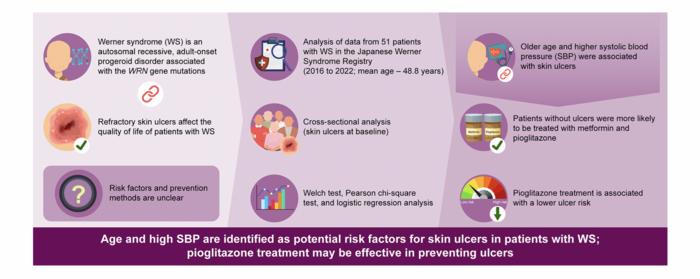In a recent publication in the peer-reviewed journal Aging, researchers from Chiba University and other institutions in Japan have revealed groundbreaking findings regarding the treatment of skin ulcers in patients with Werner syndrome, particularly focusing on the drug pioglitazone. This medication, primarily utilized in the management of diabetes, shows promise in mitigating one of the most debilitating complications of Werner syndrome, which includes severe skin ulcers that can significantly affect the quality of life for patients. The study sheds light on the intersection between diabetes management and dermatological care, emphasizing the importance of repurposing existing medications to address complex, multifactorial health issues faced by aging populations.
Werner syndrome is an exceptionally rare and severe genetic disorder characterized by accelerated aging. Patients suffering from this condition frequently experience premature graying of hair, cataracts, and an array of other age-related complications. One of the most distressing manifestations of this syndrome is the development of skin ulcers, which affect nearly 70% of those diagnosed. These ulcers not only pose significant health risks such as infections and extreme pain, but they can also lead to more serious interventions, including amputations. The social and psychological burden of these conditions adds a layer of complexity to patient management, necessitating innovative therapeutic approaches that can improve life quality.
The study, titled “Less frequent skin ulcers among patients with Werner syndrome treated with pioglitazone: findings from the Japanese Werner Syndrome Registry,” involved a comprehensive examination of 51 patients. With a significant portion of these individuals showing existing skin ulcers, the study aimed to investigate whether pioglitazone could be an effective intervention. Notably, the researchers found a marked reduction in the incidence of skin ulcers among those taking the drug, leading to a promising correlation between pioglitazone use and ulcer prevention. The researchers attributed this benefit to pioglitazone’s anti-inflammatory properties, which appear to expedite the healing process of wounds.
The implications of this study extend beyond mere statistics; they signify a pivotal moment in our approach to treating skin conditions associated with genetic disorders. The insights gleaned from this research could pave the way for additional studies exploring the roles of inflammation and wound healing in chronic conditions. Furthermore, given that pioglitazone can carry potential adverse effects—such as bone fragility—researchers suggest a deeper inquiry into safer alternative delivery mechanisms. This might include localized applications of pioglitazone in the form of creams or gels, tailored to mitigate systemic side effects while delivering therapeutic benefits directly to the affected areas.
As the research team emphasizes the need for continued exploration, they also highlight that lifestyle factors such as dietary habits and physical activity deserve attention. Such elements might interact synergistically with pharmacological agents like pioglitazone, offering a holistic approach to patient care. The multidimensional nature of health requires us to consider not only the biological impacts of medications but also the lifestyle changes that can amplify these effects, enhancing overall well-being.
Looking to the future, scientists are on the brink of developing nanostructured hybrid materials loaded with pioglitazone for potential clinical applications. This innovation may soon provide a novel avenue for ulcer treatment, promising to revolutionize wound care in patients with Werner syndrome and potentially those with other chronic skin conditions. These developments exemplify the dynamic nature of scientific exploration in healthcare, where ingenuity meets the urgent need for effective treatments.
In the grander context of aging research, this study contributes to a growing body of literature focused on slowing aging processes and treating associated diseases. As medical science evolves, the need for effective, adaptable treatments becomes increasingly paramount. The findings by Aono and Koshizaka et al. resonate deeply within this field, potentially impacting approaches to a variety of age-related health challenges faced by diverse populations globally.
The study serves as a clarion call for interdisciplinary collaboration and innovation in medical research. By bridging the gap between gerontology, pharmacology, and dermatology, researchers can enhance the quality of life for patients dealing with rare syndromes like Werner syndrome. This highlights not only the importance of scientific inquiry but also the broader implications of applying findings across different domains of health.
As the quest for understanding the complexities of aging and its associated conditions continues, studies like this serve as essential milestones. They not only provide empirical evidence supporting the repurposing of existing medications but also inspire further investigations into their broader applications. This is a testament to the potential of integrative medicine and its capacity to significantly alter treatment paradigms for previously underserviced populations.
In summary, the pioneering work conducted by the team at Chiba University is emblematic of the ongoing evolution in pharmaceutical research and its applications. With pioglitazone emerging as a potential player in the management of skin ulcers in Werner syndrome, the study underscores the importance of continually seeking out innovative solutions to complex health issues, ensuring that advancements in science translate to tangible benefits for patients.
Continued research will be essential to unlocking the full potential of pioglitazone while mitigating its risks. The promise shown in this study could lead to novel therapies that not only address wellness for patients with Werner syndrome but may also set a precedent for addressing other conditions linked to accelerated aging, creating a ripple effect that could lead to better health outcomes in various avenues of medical practice.
Subject of Research: Treatments for skin ulcers in patients with Werner syndrome
Article Title: Less frequent skin ulcers among patients with Werner syndrome treated with pioglitazone: findings from the Japanese Werner Syndrome Registry
News Publication Date: 2-Dec-2024
Web References: Aging Journal
References: DOI 10.18632/aging.206161
Image Credits: © 2024 Aono et al.
Keywords: aging, Werner syndrome, skin ulcer, metformin, pioglitazone, progeroid syndrome





